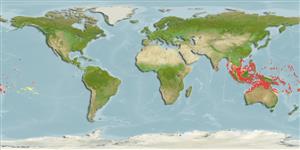>
Eupercaria/misc (Various families in series Eupercaria) >
Malacanthidae (Tilefishes)
Etymology: Hoplolatilus: Greek, hoplon = weapon + Latin, latus = wide (Ref. 45335).
Eponymy: Dr Walter Albert Starck II (d: 1939) is a marine biologist, ichthyologist and pioneer of coral reef research, who first pointed out the damselfish species to Allen while diving at Osprey Reef, Coral Sea. [...] (Ref. 128868), visit book page.
More on authors: Randall & Dooley.
Environment: milieu / climate zone / depth range / distribution range
ນິເວດວິທະຍາ
ສັດທະເລ ກ່ຽວກັນຫີນ; ລະດັບຄວາມເລິກ 20 - 105 m (Ref. 9710), usually 20 - 50 m (Ref. 27115). Tropical; 21°C - 26°C (Ref. 27115); 19°N - 23°S
Indo Pacific: Bali, Indonesia, the Philippines to Timor, north to the Mariana Islands, south to Rowley Shoals and New Caledonia; throughout Micronesia. Range extends to Pitcairn (Ref. 9710).
ຂະໜາດ / ນ້ຳໜັກ / Age
Maturity: Lm ? range ? - ? cm
Max length : 15.5 cm TL ຕົວຜູ້/ບໍ່ມີເພດ; (Ref. 90102)
ຄີ (ໜາມ)ແຂງຢູ່ຫຼັງປາ (ທັງໝົດ) : 8; ຄີຫຼັງຂອງປາ (ຄີອ່ອນ) (ທັງໝົດ) : 21 - 23; ຄີ(ໜາມ) ແຂງຢູ່ຄີກົ້ນປາ
ກຸ່ມປາກະດູກແຂງ
ຄວາມຖີ່ຂອງກຸ່ມຖ່າຍທອດພັນ
ປາທີ່ມີການເຄື່ອນຍ້າຍຈາກທະເລໄປຫານ້ຳຈືດ ແລະນ້ຳຈືດຫາທະເລ
ປາທີ່ມີການເຄື່ອນຍ້າຍຈາກທະເລແລະໄປໄຂ່ຢູ່ນ້ຳຈືດ
ຄີກົ້ນຂອງປາ
ສັດທີ່ມີກະດູກສັນຫັຼງ
ການຖ່າຍທອດທາງກຳມະພັນຈາກພໍ່ແມ່ຫາລູກ: 2; ຄີກົ້ນຂອງປາ: 15 - 16; ສັດທີ່ມີກະດູກສັນຫຼັງ: 24. Small juvenile bright blue (Ref. 48635). Preopercular serrae 30-57.
Inhabits patches of talus or rubble of steep outer reef slopes. Usually seen in pairs that quickly dive headfirst into their burrow when disturbed. Juveniles occasionally school with similarly colored juveniles of Pseudanthias pascalus. Stomach contents of 6 adult specimens consisted of copepods (31.4% by volume), pelagic tunicates (31%, larvaceans, plus Oikopleura), fish eggs (28.6%), siphonophores (5.5%), larval shrimps (1.2%), fish (0.8%), amphipods (0.7%), unidentified decapod larvae (0.5%), and heteropods (0.3) (Ref. 8991). Minimum depth reported from Ref. 27115.
Life cycle and mating behavior
ການຈະເລີນເຕັມໄວ | ການສືບພັນ | ການວາງໄຂ່ | ໄຂ່ | ຄວາມດົກຂອງໄຂ່ປາ | ຕົວອ່ອນ
Displays obligate monogamy where a one-to-one pair is established irrespective of resource abundance (Ref. 52884).
Randall, J.E. and J.K. Dooley, 1974. Revision of the Indo-Pacific branchiostegid fish genus Hoplolatilus, with descriptions of two new species. Copeia 1974(2):457-471. (Ref. 9870)
IUCN Red List Status (Ref. 130435: Version 2024-1)
Threat to humans
Harmless
Human uses
ການປະມົງ: ເປັນສີນຄ້າ; ຕູ້ປາ: ເປັນສີນຄ້າ
ເຄື່ອງມື
Special reports
Download XML
ແຫຼ່ງອີນເຕີເນັດ
Estimates based on models
Preferred temperature (Ref.
123201): 25.5 - 28.9, mean 27.7 °C (based on 362 cells).
Phylogenetic diversity index (Ref.
82804): PD
50 = 0.5001 [Uniqueness, from 0.5 = low to 2.0 = high].
Bayesian length-weight: a=0.01122 (0.00514 - 0.02450), b=3.04 (2.87 - 3.21), in cm total length, based on all LWR estimates for this body shape (Ref.
93245).
ຊັ້ນເຂດຮ້ອນ (Ref.
69278): 3.5 ±0.0 se; based on diet studies.
Fishing Vulnerability (Ref.
59153): Low vulnerability (10 of 100).
Nutrients (Ref.
124155): Calcium = 84 [53, 138] mg/100g; Iron = 0.821 [0.533, 1.260] mg/100g; Protein = 18.2 [16.0, 20.2] %; Omega3 = 0.174 [0.113, 0.265] g/100g; Selenium = 30.1 [17.6, 53.3] μg/100g; VitaminA = 176 [69, 438] μg/100g; Zinc = 1.41 [1.00, 1.91] mg/100g (wet weight);
